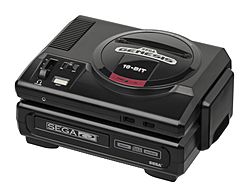Sega CD facts for kids
 |
|
|
Top: Original Sega CD (bottom) attached to a Model 1 Genesis.
Bottom: Model 2 Sega CD (on right) attached to a Model 2 Genesis. Other variations are pictured under Variations below |
|
| Also known as | Mega-CD (most regions outside North America and Brazil) |
|---|---|
| Manufacturer | Sega |
| Type | Video game console add-on |
| Generation | Fourth generation |
| Release date |
|
| Retail availability | 1991-1996 |
| Introductory price | JP¥49,800 US$299 GB£270 |
| Discontinued | 1996 |
| Units sold | 2.24 million |
| Media | CD-ROM, CD+G |
| CPU | Motorola 68000 @ 12.5 MHz |
| Storage | 64 kbit internal RAM |
| Sound | Ricoh RF5C164 |
| Best-selling game | Sonic CD, 1.5 million |
| Related articles | 32X |
The Sega CD was a special add-on for the Sega Genesis video game console. It let players use games stored on CDs. Sega, a famous video game company, released it first in Japan in 1991. Later, it came to North America in 1992 and Europe in 1993.
This device was a big step for Sega. It was their first time using CDs for games. The Sega CD added new power to the 16-bit Genesis. It allowed for better graphics and sound. While it had some success, many people felt there weren't enough really great games for it.
Contents
What Was the Sega CD?
The Sega CD was an accessory that attached to the bottom or side of a Sega Genesis console. It used CD-ROM discs, which could hold much more data than the Genesis's game cartridges. This meant games could have more detailed graphics, better music, and even full-motion video (FMV) clips.
How Did the Sega CD Work?
The Sega CD had its own powerful Motorola 68000 processor. This chip helped the Genesis handle the new CD games. It also had extra memory and a special sound chip. These additions made games look and sound much better than standard Genesis games.
Why Use CDs for Games?
CDs offered several advantages over game cartridges. They were cheaper to make and could store a lot more information. This allowed game developers to create bigger worlds and include more features. For example, games could have high-quality soundtracks and animated video scenes.
Popular Games and Features
One of the most famous games for the Sega CD was Sonic CD. This game showed off the system's abilities with its smooth graphics and cool music. It also had animated cutscenes, which were very new at the time.
Full-Motion Video (FMV) Games
The Sega CD was known for its full-motion video games. These games used real video clips as part of the gameplay. While this was exciting, the video quality was often not perfect. Games like Night Trap and Sewer Shark were popular examples of FMV games.
Enhanced Sound and Graphics
Beyond FMV, the Sega CD improved game sound. It offered CD-quality audio, making game music much richer. Graphics also saw a boost, with more colors and special effects possible. This helped create more immersive game worlds.
The Sega CD's Journey
The Sega CD was released during a time of big changes in video games. Many companies were looking into CD technology. Sega hoped the Sega CD would keep them ahead of their rivals.
Release and Price
The Sega CD first launched in Japan in late 1991. It cost about ¥49,800, which was quite expensive. When it came to North America, it was priced at US$299. This high price made it hard for many families to buy.
Competition and Challenges
The Sega CD faced tough competition. Other companies were also developing CD-based systems. Also, many gamers felt the games didn't always use the Sega CD's full power. This led to some disappointment among players.
Discontinuation
The Sega CD was sold until 1996. By then, newer consoles with even more advanced technology were coming out. Sega decided to focus on their next big console, the Sega Saturn. In total, about 2.24 million Sega CD units were sold worldwide.
Images for kids
See also
 In Spanish: Sega CD para niños
In Spanish: Sega CD para niños





